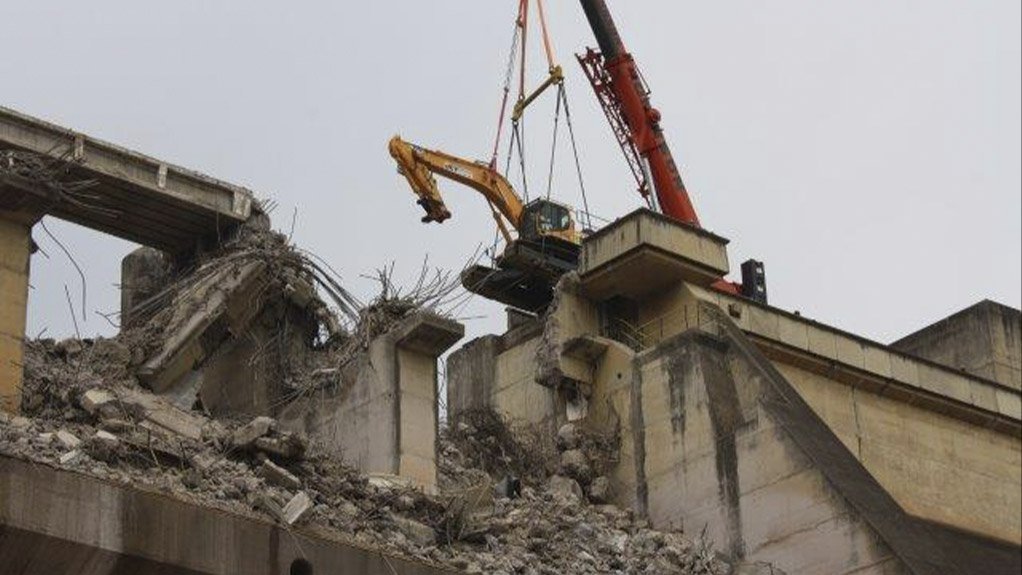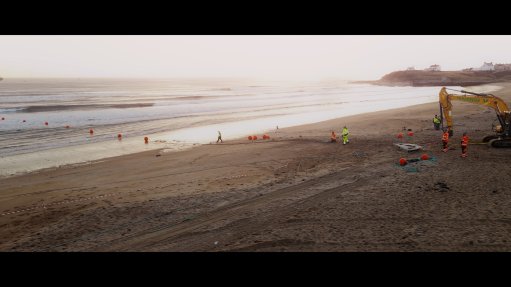Latest blasting techniques for rehabilitation of dam walls
This article has been supplied.
New blasting techniques have been developed specifically to retain the structural stability of dams themselves, with no wasted effort. These projects call for highly controlled, cautious, partial demolition techniques. Therefore Jet Demolition’s work on large water-retaining dams are some of the most important projects the specialist contractor has undertaken to date.
Rehabilitation of dam walls usually requires demolition of redundant portions of monolithic blocks and associated concrete structures. Dynamic energy imparted by the demolition process has the potential to cause damage to concrete located just across the demolition boundaries and beyond. While it is essential to avoid damage to remaining concrete, it is also important to carry out the demolition works in a productive and cost-effective manner.
Hence, informed and judicious selection of demolition methods and their application techniques are vital to a controlled and productive project – which is where Jet Demolition’s extensive experience stands it in good stead, explains Contracts Manager Kate Bester. “Our work at Hazelmere Dam allowed for the compilation of specific demolition-control guidelines to be developed for dam rehabilitation projects.”
Here a combination of explosive, mechanical, and diamond-cutting methods were employed. It was demonstrated that explosives can be used as the primary method of demolition on dam rehabilitation projects in a safe, productive, and controlled manner, without causing damage to the remaining mass concrete and concrete structures.
Located on the Mdloti River in KwaZulu-Natal, the Hazelmere Dam was built in the 1970s. It was designed originally to accept radial arm gates to raise the Full Supply Level (FSL). However, a subsequent redesign showed that the FSL would be achieved optimally via a Piano Key Weir (PKW).
To clear the way for new construction works, demolition of the existing spillway crest, piers, lintel beam, and bridge decks required the controlled removal of 5 300 m3 of concrete up to 3 m in thickness. The key requirements were to demolish the redundant structures in a safe, rapid, cost-effective, and controlled manner, without residual damage.
The traditional demolition method for projects with large volumes of mass concrete is explosives, with large hydraulic hammers used for the smaller concrete sections and for secondary breakage. Finishing work is typically undertaken by small hydraulic hammers and handheld breakers.
Despite the advances in diamond-cutting technologies, this method is usually not practical nor cost-effective to apply in isolation. The use of drilling and blasting is unrivalled in terms of speed and cost-effectiveness. However, for obvious dam-safety reasons, maintaining the structural integrity of the remaining concrete is a perennial concern when demolition works are carried out on a dam structure, or in nearby rock.
When considering safe blasting vibration levels for a particular project, it is critical to consider the prevailing site conditions and geometrical configurations. “At Hazelmere Dam, our production blasting programme and demolition methods achieved all of these objectives successfully,” concludes Bester.
Article Enquiry
Email Article
Save Article
Feedback
To advertise email advertising@creamermedia.co.za or click here
Comments
Press Office
Announcements
What's On
Subscribe to improve your user experience...
Option 1 (equivalent of R125 a month):
Receive a weekly copy of Creamer Media's Engineering News & Mining Weekly magazine
(print copy for those in South Africa and e-magazine for those outside of South Africa)
Receive daily email newsletters
Access to full search results
Access archive of magazine back copies
Access to Projects in Progress
Access to ONE Research Report of your choice in PDF format
Option 2 (equivalent of R375 a month):
All benefits from Option 1
PLUS
Access to Creamer Media's Research Channel Africa for ALL Research Reports, in PDF format, on various industrial and mining sectors
including Electricity; Water; Energy Transition; Hydrogen; Roads, Rail and Ports; Coal; Gold; Platinum; Battery Metals; etc.
Already a subscriber?
Forgotten your password?
Receive weekly copy of Creamer Media's Engineering News & Mining Weekly magazine (print copy for those in South Africa and e-magazine for those outside of South Africa)
➕
Recieve daily email newsletters
➕
Access to full search results
➕
Access archive of magazine back copies
➕
Access to Projects in Progress
➕
Access to ONE Research Report of your choice in PDF format
RESEARCH CHANNEL AFRICA
R4500 (equivalent of R375 a month)
SUBSCRIBEAll benefits from Option 1
➕
Access to Creamer Media's Research Channel Africa for ALL Research Reports on various industrial and mining sectors, in PDF format, including on:
Electricity
➕
Water
➕
Energy Transition
➕
Hydrogen
➕
Roads, Rail and Ports
➕
Coal
➕
Gold
➕
Platinum
➕
Battery Metals
➕
etc.
Receive all benefits from Option 1 or Option 2 delivered to numerous people at your company
➕
Multiple User names and Passwords for simultaneous log-ins
➕
Intranet integration access to all in your organisation





















